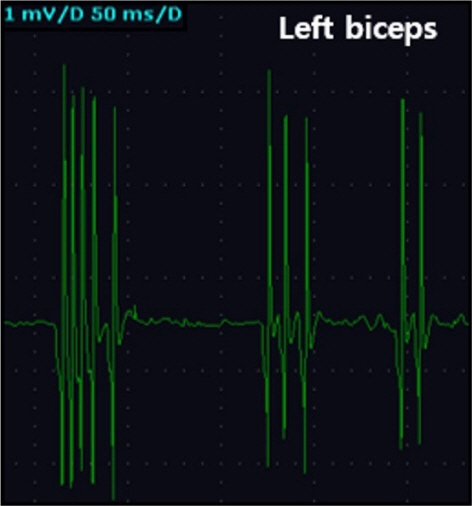J Neurocrit Care.
2022 Jun;15(1):57-60. 10.18700/jnc.220057.
Morvan syndrome presenting with agrypnia excitata in post-thymectomy myasthenia gravis: a case report
- Affiliations
-
- 1Department of Neurology, Busan Paik Hospital, Inje University College of Medicine, Busan, Korea
- 2Neuroimmunology Research Group, Inje University Busan Paik Hospital, Busan, Korea
- KMID: 2532001
- DOI: http://doi.org/10.18700/jnc.220057
Abstract
- Background
Morvan syndrome is characterized by neuromyotonia, dysautonomia, and various neuropsychiatric symptoms, as well as sleep disturbances, although these are less common than neuromuscular symptoms. Herein, we report a case of Morvan syndrome with peculiar sleep disturbances, documented via polysomnography.
Case Report
We present herein the case of a 67-year-old man who developed agitation and severe insomnia after undergoing a thymectomy for the treatment of myasthenia gravis, which was subsequently diagnosed as agrypnia excitata due to Morvan syndrome, based on 24-hour polysomnography.
Conclusion
We presented the 24-hour polysomnographic findings of a case of agrypnia excitata in Morvan syndrome. An extended polysomnography, however, might be helpful in analyzing sleep disturbances in Morvan syndrome.
Keyword
Figure
Reference
-
1. Irani SR, Pettingill P, Kleopa KA, Schiza N, Waters P, Mazia C, et al. Morvan syndrome: clinical and serological observations in 29 cases. Ann Neurol. 2012; 72:241–55.
Article2. Provini F. Agrypnia excitata. Curr Neurol Neurosci Rep. 2013; 13:341.
Article3. Bernard C, Frih H, Pasquet F, Kerever S, Jamilloux Y, Tronc F, et al. Thymoma associated with autoimmune diseases: 85 cases and literature review. Autoimmun Rev. 2016; 15:82–92.
Article4. Michael S, Waters P, Irani SR. Stop testing for autoantibodies to the VGKC-complex: only request LGI1 and CASPR2. Pract Neurol. 2020; 20:377–84.
Article5. Montagna P, Lugaresi E. Agrypnia Excitata: a generalized overactivity syndrome and a useful concept in the neurophysiopathology of sleep. Clin Neurophysiol. 2002; 113:552–60.
Article6. Cirelli C, Bushey D, Hill S, Huber R, Kreber R, Ganetzky B, et al. Reduced sleep in drosophila shaker mutants. Nature. 2005; 434:1087–92.
Article7. Espinosa F, Marks G, Heintz N, Joho RH. Increased motor drive and sleep loss in mice lacking Kv3-type potassium channels. Genes Brain Behav. 2004; 3:90–100.
Article8. Abgrall G, Demeret S, Rohaut B, Leu-Semenescu S, Arnulf I. Status dissociates and disturbed dreaming in a patient with Morvan syndrome plus myasthenia gravis. Sleep Med. 2015; 16:894–6.9. Cornelius JR, Pittock SJ, McKeon A, Lennon VA, Aston PA, Josephs KA, et al. Sleep manifestations of voltage-gated potassium channel complex autoimmunity. Arch Neurol. 2011; 68:733–8.
Article10. Yang TW, Park B, Kim KT, Jun JS, Kim YS, Lee ST, et al. Fatal familial insomnia presenting with agrypnia excitata and very low atonia index level: a case report and literature review. Medicine (Baltimore). 2018; 97:e0646.
- Full Text Links
- Actions
-
Cited
- CITED
-
- Close
- Share
- Similar articles
-
- Balanced Anesthesia with Thalamonal for Thymectomy in Myasthenia Gravis
- Anesthetic Management for Thymectomy in the Patients with Myasthenia Gravis - A report 2 of cases
- Anesthesia for Thymectomy in Patient with Myasthenia Gravis - Two cases report
- Anesthesia for Thymectomy in Myasthenis Gravis - A case report
- A Case of Graves' Disease associated with Myasthenia Gravis treated by Bilateral Subtotal Thyroidectomy and Total Thymectomy



